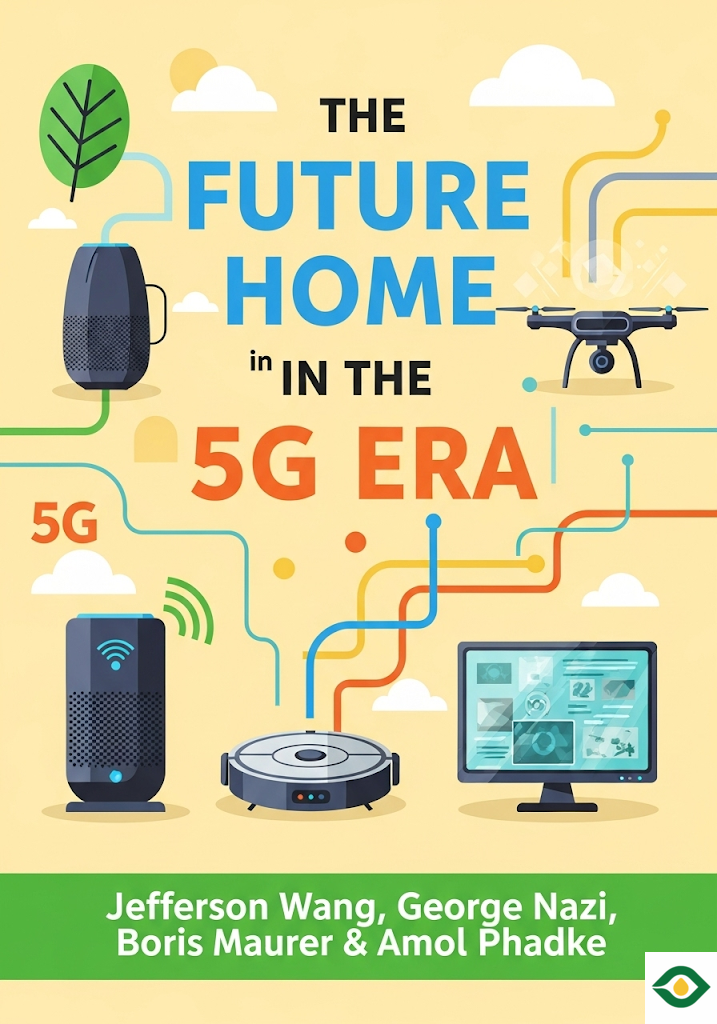Description
Imagine a home that feels almost alive—anticipating your needs, adjusting itself to your habits, and making daily life easier and more enjoyable. Instead of juggling separate gadgets and apps, everything works together smoothly. The coffee machine brews your morning cup, the thermostat keeps the temperature perfect, the lights shift with your mood, and even health checkups happen from the comfort of your living room. This is the vision of the future home in the 5G era: a place where technology quietly blends into life, creating comfort, security, and convenience.
Many of the building blocks for such a home already exist. We have smart speakers, connected lights, and automated security systems. But today, most of them operate in isolation. Your smart fridge doesn’t talk to your smart TV, and your robotic vacuum doesn’t coordinate with your home security system. The real transformation will happen when all these devices can communicate freely and act together, and 5G is the network standard that makes this possible.
5G, which stands for “fifth generation” wireless technology, brings a leap in speed, reliability, and connectivity. Compared to 4G or traditional home Wi-Fi, it offers ultra-fast response times, huge capacity, and wide coverage. That means not just one or two devices connected, but potentially millions of devices per square kilometer. For a home filled with interconnected gadgets, this is essential. With such speed and capacity, your devices will respond instantly, share data in real time, and deliver seamless experiences.
For example, imagine coming home from work. Your car signals the house as you approach. The lights turn on, your favorite playlist starts playing, the oven begins preheating for dinner, and the temperature adjusts to your liking. This isn’t science fiction; it’s the promise of a home where connectivity is so smooth that everything feels natural and effortless.
But 5G is only part of the story. Other technologies like edge computing and eSIMs will also play crucial roles. Edge computing allows data to be processed close to where it’s generated—right in your neighborhood, or even inside your home—rather than traveling back and forth to faraway servers. This reduces delays and makes real-time services, like health monitoring or security alerts, much more reliable. eSIMs, meanwhile, let devices switch networks easily without physical SIM cards, keeping everything connected no matter the provider. Together, these advances will power the next generation of smart homes.
The demand for this kind of technology will be driven by new consumer expectations, especially from Millennials and Gen Z. These generations grew up with digital services and expect technology to be personal, easy, and automatic. They don’t want complicated setups or confusing manuals. They want homes that “just work”—where devices are installed in minutes and begin learning preferences immediately.
At the same time, aging populations will also benefit. Many older people prefer to live independently, and smart home technology could help them do so safely. Remote health monitoring, virtual doctor visits, fall detection sensors, and connected emergency services could transform elderly care, giving both families and individuals peace of mind.
Different types of consumers will want different things from their future homes. Some will see their home as a reflection of personal style and social status, investing in cutting-edge gadgets to impress visitors. Others will focus on comfort, safety, and family. Some will be eager early adopters of new technology, while others will wait for proven, reliable solutions. To succeed, companies building future home technology will need to understand these diverse preferences and tailor their offerings accordingly.
Of course, challenges remain. One major problem is data fragmentation. Currently, companies often keep their systems closed, unwilling to share information with others. But a truly connected home can’t exist if devices don’t talk to each other. A fridge that won’t share its data with a grocery service, or a security system that won’t integrate with smart locks, breaks the seamless experience. For progress to happen, companies must embrace cooperation and shared standards.
Another big challenge is privacy and security. If every part of your home—from your bathroom mirror to your front door—collects and stores personal data, protection becomes critical. Clear and transparent rules for how data is handled will be necessary, as well as stronger defenses against hacking and misuse. Users will demand control over their own information, and trust will be essential for adoption.
Cost is also a barrier. Right now, many smart devices are far more expensive than their traditional counterparts. To make future homes accessible to the average household, prices will need to fall. This can only happen if demand grows and production scales up, driving costs down.
So, who will lead the charge in making the future home a reality? Surprisingly, the strongest candidates are not just gadget makers, but communication service providers (CSPs) like major telecom companies. They already manage huge networks, provide customer service at scale, and enjoy relatively high levels of public trust. Since they will deliver the 5G backbone, they are well placed to become the central coordinators of future homes.
However, to succeed, CSPs will need to adapt. They must go beyond simply providing internet connections and offer complete platforms that bring together devices, services, and users. They’ll need faster innovation, flexible business models, and strong partnerships with other companies. Some have already started experimenting with AI-based customer service, proactive support, and smart home bundles.
The most likely model for the future home is a platform ecosystem—similar to how Amazon operates today. Amazon doesn’t just sell products; it connects millions of sellers, developers, and customers in one space, creating a vibrant marketplace. A future home platform could work the same way, allowing developers to create apps for smart homes, manufacturers to offer compatible devices, and customers to enjoy a wide range of services.
For such an ecosystem to work, trust and fairness will be key. No single company should control all the data. Instead, a neutral system, possibly regulated and shared among multiple players, will need to be developed. This would ensure privacy, security, and equal opportunity for innovation.
If all these elements come together—5G networks, edge computing, open platforms, affordable devices, and strong privacy safeguards—the future home could arrive sooner than expected. It would not just be about gadgets, but about creating a living environment that adapts to people’s lifestyles, saves time, supports health, reduces waste, and even strengthens social connections.
In the end, the future home is not about machines taking over our lives. It’s about technology fading into the background and giving us more freedom, comfort, and choice. Instead of managing dozens of disconnected devices, we’ll enjoy a single, harmonious system that quietly makes life better.
The vision is clear: a hyper-connected, personalized, and secure home environment, shaped by new technologies and consumer needs. The road to get there will have obstacles, but the destination promises a world where homes are smarter, safer, and more human-centered than ever before.





